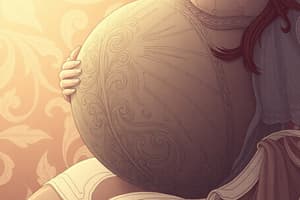Podcast
Questions and Answers
Which fetal position is most ideal for vaginal birth?
Which fetal position is most ideal for vaginal birth?
- Left Occipito-anterior position (correct)
- Right Occipito-anterior position
- Occipito-transverse position
- Occipito-posterior position
What maternal risks are associated with occipito-posterior position of the fetus?
What maternal risks are associated with occipito-posterior position of the fetus?
- Descent and flexion
- Intense back pain
- Extension of an episiotomy
- Potential for operative delivery (correct)
What complications may occur during delivery in occipito-posterior position?
What complications may occur during delivery in occipito-posterior position?
- Perineal tears (correct)
- Descent and flexion
- Internal rotation complete
- Extension of an episiotomy
Which fetal head position may lead to arrested labor?
Which fetal head position may lead to arrested labor?
What maternal symptoms are often seen in labor with occipito-posterior position?
What maternal symptoms are often seen in labor with occipito-posterior position?
Which fetal presentation is assessed during labor?
Which fetal presentation is assessed during labor?
Flashcards are hidden until you start studying
Study Notes
Fetal Position for Vaginal Birth
- The ideal fetal position for vaginal birth is the occipito-anterior (OA) position, where the baby's head is facing down with the back of the head towards the mother's abdomen.
Maternal Risks with Occipito-Posterior Position
- Occipito-posterior (OP) position can increase maternal fatigue and discomfort during labor.
- Risk of prolonged labor due to less efficient contractions and fetal positioning.
- Higher likelihood of requiring interventions such as forceps or vacuum extraction.
Complications During Delivery in Occipito-Posterior Position
- Increased chance of abnormal fetal heart patterns due to compression of the umbilical cord.
- Potential for perineal lacerations or episiotomy due to challenging delivery angle.
- Higher incidence of cesarean delivery due to difficulties in progressing labor.
Fetal Head Position Leading to Arrested Labor
- The brow position can lead to arrested labor, where the fetal head is not in a favorable position for descent.
Maternal Symptoms in Labor with Occipito-Posterior Position
- Increased back pain, often described as back labor, due to pressure on the sacrum.
- Reports of ineffective contractions despite ongoing labor.
- Higher rates of maternal anxiety and stress due to prolonged labor.
Fetal Presentation Assessed During Labor
- During labor, the fetal presentation typically assessed is the position of the baby's head relative to the mother's pelvis, specifically whether it's in the OA, OP, or other positions.
Studying That Suits You
Use AI to generate personalized quizzes and flashcards to suit your learning preferences.




